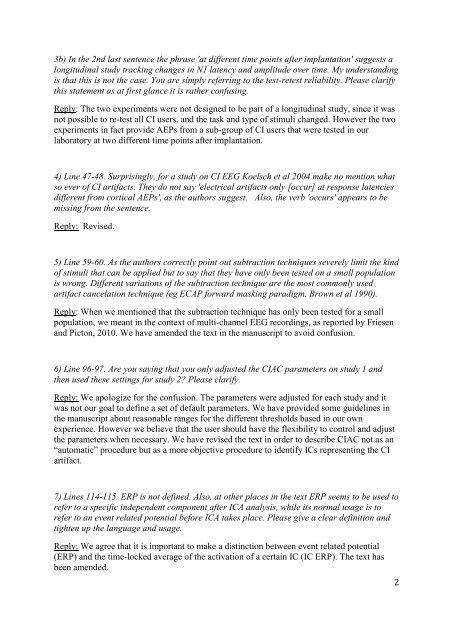Elsevier Editorial System(tm) for Hearing Research Manuscript Draft ...
Elsevier Editorial System(tm) for Hearing Research Manuscript Draft ...
Elsevier Editorial System(tm) for Hearing Research Manuscript Draft ...
Create successful ePaper yourself
Turn your PDF publications into a flip-book with our unique Google optimized e-Paper software.
3b) In the 2nd last sentence the phrase 'at different time points after implantation' suggests a<br />
longitudinal study tracking changes in N1 latency and amplitude over time. My understanding<br />
is that this is not the case. You are simply referring to the test-retest reliability. Please clarify<br />
this statement as at first glance it is rather confusing.<br />
Reply: The two experiments were not designed to be part of a longitudinal study, since it was<br />
not possible to re-test all CI users, and the task and type of stimuli changed. However the two<br />
experiments in fact provide AEPs from a sub-group of CI users that were tested in our<br />
laboratory at two different time points after implantation.<br />
4) Line 47-48. Surprisingly, <strong>for</strong> a study on CI EEG Koelsch et al 2004 make no mention what<br />
so ever of CI artifacts. They do not say 'electrical artifacts only [occur] at response latencies<br />
different from cortical AEPs', as the authors suggest. Also, the verb 'occurs' appears to be<br />
missing from the sentence.<br />
Reply: Revised.<br />
5) Line 59-60. As the authors correctly point out subtraction techniques severely limit the kind<br />
of stimuli that can be applied but to say that they have only been tested on a small population<br />
is wrong. Different variations of the subtraction technique are the most commonly used<br />
artifact cancelation technique (eg ECAP <strong>for</strong>ward masking paradigm, Brown et al 1990).<br />
Reply: When we mentioned that the subtraction technique has only been tested <strong>for</strong> a small<br />
population, we meant in the context of multi-channel EEG recordings, as reported by Friesen<br />
and Picton, 2010. We have amended the text in the manuscript to avoid confusion.<br />
6) Line 96-97. Are you saying that you only adjusted the CIAC parameters on study 1 and<br />
then used these settings <strong>for</strong> study 2? Please clarify.<br />
Reply: We apologize <strong>for</strong> the confusion. The parameters were adjusted <strong>for</strong> each study and it<br />
was not our goal to define a set of default parameters. We have provided some guidelines in<br />
the manuscript about reasonable ranges <strong>for</strong> the different thresholds based in our own<br />
experience. However we believe that the user should have the flexibility to control and adjust<br />
the parameters when necessary. We have revised the text in order to describe CIAC not as an<br />
“automatic” procedure but as a more objective procedure to identify ICs representing the CI<br />
artifact.<br />
7) Lines 114-115. ERP is not defined. Also, at other places in the text ERP seems to be used to<br />
refer to a specific independent component after ICA analysis, while its normal usage is to<br />
refer to an event related potential be<strong>for</strong>e ICA takes place. Please give a clear definition and<br />
tighten up the language and usage.<br />
Reply: We agree that it is important to make a distinction between event related potential<br />
(ERP) and the time-locked average of the activation of a certain IC (IC ERP). The text has<br />
been amended.<br />
2
















